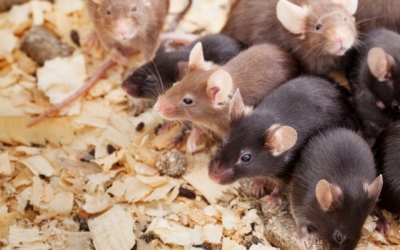- Latest news▼
-
12:16, April 19 Scientists grow human mini-lungs in lab

-
10:23, April 19 JAMA Oncology: Urine test can help rule out high-grade prostate cancer with almost 100% accuracy, study shows

-
18:00, April 18 Daily Mail: Elderly woman in China gets infected with brain-eating amoeba

-
14:19, April 18 Obesity: exercising before breakfast helps you lose weight faster

-
10:42, April 18 The Conversation: childhood trauma can cause pathological hoarding

-
08:37, April 18 Daily Mail: Satiating food reduces cravings for sweets, nutritionist says

-
18:22, April 17 First Armenian-German Conference entitled “Heart Failure Spring School”

-
08:38, April 17 Why do kids usually recover from COVID-19 more easily than adults?

-
14:37, April 16 Daily Mail: intermittent fasting is not suitable for children and women before their periods

-
16:41, April 15 Cell: in carriers of defective BRCA2 gene, sugar consumption increases cancer risk

-
15:04, April 15 305 cases of measles recorded in Armenia so far in 2024

-
14:38, April 15 Food and Environmental Virology: tea contributes to effective coronavirus control

-
12:41, April 15 Daily Mail: vitamin A, B3 and E supplements can be dangerous

-
10:56, April 15 Diabetes Care: evening physical activity is good for the heart

-
08:27, April 15 Women are more susceptible to blood loss and death during bypass surgery than men, researchers say

All materials
Scientists created male mice able to reproduce without Y chromosomes

Mice whose Y chromosomes have been replaced with just two genes are still able to father offspring, demonstrating the unexpected complexity of reproductive genetics.
High school genetics has a simple story about sex chromosomes: Women have two X chromosomes, while men have an X and a Y. The presence of a Y chromosome is what defines biological maleness. Sometimes more unusual situations, such as XXY or XYY, get a mention, but reproduction without a Y is something new.
The Y chromosome is much smaller than the X, carrying far fewer genes. In 2014, Professor Monika Ward of the University of Hawaii revealed that only two of these Y chromosome genes, known as Sry and Eif2s3y, are enough to enable male mice to reproduce, even if the rest of the chromosome is removed.
Sry, for "sex-determining region Y," targets the Sox9 gene, which sits on the 17th chromosome in humans and the 11th in mice, rather than on the sex chromosomes. Ward cut out the “middle gene” by removing the entire Y chromosome and promoting the overexpression of Sox9, which promotes testes development. Previous work showed that overexpressing Sox9 in genetically female (XX) mice caused them to develop male characteristics. Ward also encouraged greater expression of the gene Eif2s3x on the X chromosome with a similar structure to Eif2s3y, a gene crucial to sperm formation, or spermatogenesis.
Some of the engineered mice produced sperm, and Ward and her colleagues report in Science that when they attempted to artificially inseminate female mice with their product, at least 10 of the Y-less mice were fertile.
Not all of these mice, dubbed X0 for having a single X chromosome without a match, turned out well, with 35 out of 48 having testicular defects and a lack of sperm. Using sperm from the other 13 mice, 10 led to pregnancies and nine to live births. All of these, Ward told IFLScience, were healthy and lived normal-length lives for rats.
The authors note that the more highly expressed the Eif2s3x genes were, the further the mice got through the sperm production process.
“We are currently not working towards any specific application,” Ward told IFLScience. “We want to advance the understanding of Y chromosome gene function, and understanding of X-Y gene pairs.”
She added: “Our findings could be, however, applied to the development of bi-maternal reproduction, where one female would generate sperm and the other oocytes, or one female would generate both. Demonstrating that this could be done is interesting from a basic science point of view and would support the plasticity of the genome.”
“There might be a practical value in this too,” Ward continued. “Such an alternative form of reproduction could, for example, be applied in species preservation. If we end up with just one female of a given species, being able to develop both male and female gametes from one individual would help to prevent its extinction. Bi-maternal reproduction might also be useful in agriculture, if it is more desirable to combine genetic material from two females rather than from a female and a male.”
Follow NEWS.am Medicine on Facebook and Twitter
- Video
- Event calendar
- Archive
- Most read
month
week
day
- WHO: Nigeria pioneers revolutionary meningitis vaccine 1184
- One-third of women experience menstruation-related migraines, most often during premenopause - study 1171
- Daily Mail: vitamin A, B3 and E supplements can be dangerous 1024
- Food and Environmental Virology: tea contributes to effective coronavirus control 1016
- Cell: in carriers of defective BRCA2 gene, sugar consumption increases cancer risk 989
- 305 cases of measles recorded in Armenia so far in 2024 981
- Women are more susceptible to blood loss and death during bypass surgery than men, researchers say 969
- Diabetes Care: evening physical activity is good for the heart 925
- Daily Mail: intermittent fasting is not suitable for children and women before their periods 799
- First Armenian-German Conference entitled “Heart Failure Spring School” 580
- Why do kids usually recover from COVID-19 more easily than adults? 467
- Obesity: exercising before breakfast helps you lose weight faster 466
- The Conversation: childhood trauma can cause pathological hoarding 463
- Daily Mail: Elderly woman in China gets infected with brain-eating amoeba 443
- Daily Mail: Satiating food reduces cravings for sweets, nutritionist says 439
- Find us on Facebook
- Poll





